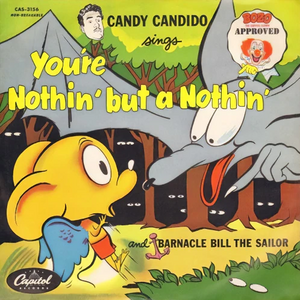You're Nothing But A Nothing

You're Nothing But A Nothing ist ein Cartoonsong aus „Die fliegende Maus“ (The Flying Mouse, 1934). Er wurde von Frank Churchill oder Leigh Harline komponiert[1] und von Frank Churchill mit Larry Morey getextet. Im englischen Original des Cartoons singt Billy Sheets das Lied.[2]
In dem Cartoon wird das Spottlied von den Fledermäusen gesungen, als sie erfahren, dass ihr neuer fliegender Höhlenbesucher nur eine Maus ist, der eine Fee Flügel gegeben hatte. Sie verhöhnen die geflügelte Maus, da diese trotz Flügel nie eine von ihnen sein wird.[2]
Entstehung und Hintergrund[Bearbeiten]
Durch den Erfolg von „Wer hat Angst vor'm bösen Wolf?“ im Jahr zuvor wurden auch andere Cartoon-Lieder textlich und musikalisch ausgearbeitet und als Notenblätter angeboten. Ohne Ann Ronell, welche „Wer hat Angst vor'm bösen Wolf?“ ausarbeitete, beauftragten die Disney-Studios den Songschreiber Larry Morey, aus kurzen Cartoon-Jingles komplette Lieder mit Strophen und Refrains zu erstellen. 1934 erschien dank Moreys Ausarbeitung eine sechsseitige Notenblatt-Fassung von Churchills „You're Nothing But A Nothing“ bei Irving Berlin, Inc., auf dem Titelblatt stilisiert als „You'r Nothin' But A Nothin'“.[3] „I Would Like to Be a Bird“, das andere Lied aus dem Cartoon, wurde dabei übergangen.
Die Schallplattenfirma Victor veröffentlichte 1934 und 1935 mehrere Schallplatten in ihrer Black label-Reihe, darunter drei von vier geplanten „Silly Symphonies“-Liedern. Umgesetzt wurde die Musik von Raymond Paige & His Orchestra, als Refrain-Chor wurden die Three Rhythm Kings benutzt. Ansonsten wurden wie beworben die Original-Cartoonstimmen verwendet: Annette Mills und Clarence Nash für die Black label-LP „The Wise Little Hen“, Pinto Colvig für „The Grasshopper And The Ants“ und Billy Sheets für „You’re Nothing But A Nothing“. Ein viertes Lied, „Peculiar Penguins“, wurde aufgenommen, aber nie veröffentlicht.[1] The Three Rhythm Kings wurden später Teil des Quartetts The Pied Pipers mit Jo Stafford und später June Hutton als vierte Person.[4]
Liedtexte[Bearbeiten]
englische Cartoon-Fassung (1934)[Bearbeiten]
- You're nothin' but a nothin'
- A nothin', a nothin'
- You're nothin' but a nothin'
- You're not a thing at all
- You're nothin' but a nothin'
- A nothin', a nothin'
- You're nothin' but a nothin'
- You're nothin', you're nothin'
- Nothin'
Notenblatt / englische Fassung von Raymond Paige (1934)[Bearbeiten]

- There was a mouse who longed to be a bird and fly above.
- He asked a fairy queen he knew to kindly help him out.
- This fairy queen gave him some wings and told him he could fly.
- And right away this little mouse went sailing through the sky.
- He flew into a big black cave and hanging overhead,
- There was a great big ugly bat who spoke right up and said,
- „Hello there kid, you sure look like a brother bat to me.“
- „Oh no, I'm not! I'm a mouse! That's all I claim to be.“
- „Now lookie here, no mouse can fly, so if you ain't a bat,
- There's only one thing you can be:
- You're nothin'. Think of that!“
- You're nothin' but a nothin'!
- A nothin'! A nothin'!
- You're nothin' but a nothin'! You're not a thing at all!
- To be a bat's a rum thing,
- A silly and a glum thing.
- At least a bat is something! You're not a thing at all!
- He looked up suddenly and saw the fairy queen he knew.
- „I'll take away your wings if you would like me to.“
- Just be yourself, and then no one can ever say to you:
- You're nothin' but a nothin'!
- A nothin'! A nothin'!
- You're nothin' but a nothin'! You're not a thing at all!
- To be a bat's a bum thing,
- A silly and a dumb thing.
- At least a bat is something! You're not a thing at all!
Fassung von Candy Candido (1953)[Bearbeiten]

1953 veröffentlichte Candy Candido in der Schallplattenreihe „Bozo The Capitol Clown Approved“ das Lied auf der titelgebenden A-Seite und dem Lied „Barnacle Bill The Sailor“ auf der B-Seite.[5] Seine Fassung des Liedes wurde zum Liedende noch um einen Dialog zwischen der Fee und der Maus ergänzt:
- Please remember to be glad that you are what you are
- You're better off in a lot of ways than many folks by far
- And as you go along through life no matter what you do
- Just be yourself so no one else can ever say to you
- You're nuthin' but a nuthin' a nuthin' a nuthin'
- Oh yes I am
- Oh no you're not
- You're not a nothing at all.
Candy Candido wurde auch im selben Jahr als Sprecher des Häuptlings in Disneys „Peter Pan“ bekannt, der ersten von vielen Sprecherrollen für das Studio.[6]
Trivia[Bearbeiten]
In der Dokumentation „Frank and Ollie“ bezeichnet Frank Thomas die Szene, in der die Fledermäuse die Maus verspotten, als eine der der ersten Male, dass Emotionen und Pathos von einer Zeichentrickfigur dargestellt wurden.[7]
Weblinks[Bearbeiten]
- Das Cartoon-Lied auf YouTube

- You're Nothing But A Nothing von Raymond Paige auf YouTube

- You're Nothing But A Nothing auf Disney Fandom
- You’re Nothin’ but a Nothin’ auf D23
Einzelnachweise[Bearbeiten]
- ↑ 1,0 1,1 James Parten (05.11.2017). „Sing Me A Cartoon #17: Turning the Paige“. cartoonresearch.com
- ↑ 2,0 2,1 „You're Nothin' But a Nothin'“. disney.fandom.com
- ↑ waresnsuchpawnshop. „1934 Walt Disney Sheet Music “You'r Nothin But a Nothin” Symphony Flying Mouse“. ebay.com, (archiviert)
- ↑ „You're Nothin' But A Nothin'“. madmusic.com
- ↑ „Candy Candido – You're Nothin' But A Nothin'“. discogs.com
- ↑ „Barnacle Bill the Sailor“. muppet.fandom.com
- ↑ „The Flying Mouse“. disney.fandom.com